ICT40115 - Practical Assignment: Windows 10 Installation and Security
VerifiedAdded on 2022/12/23
|9
|1278
|1
Practical Assignment
AI Summary
This practical assignment report details the process of installing and configuring Windows 10 Professional. It begins with disk partitioning, explaining how to create partitions, choose the NTFS file system, and allocate space for the operating system and user files. The report then covers setting up user accounts, including creating an administrator account and standard user accounts, along with creating permissions on folders. The configuration of firewalls is discussed, including turning on Windows Defender Firewall for both private and public networks and performing scans. The assignment also includes steps for installing Windows 10, evaluating different versions, and setting up a start message using the local group policy editor. Finally, the report explains how to create a backup drive using VM Oracle Virtual Machine, create a virtual hard disk, and share folders for backup. The author concludes with a positive reflection on the learning experience gained from the practical tasks.
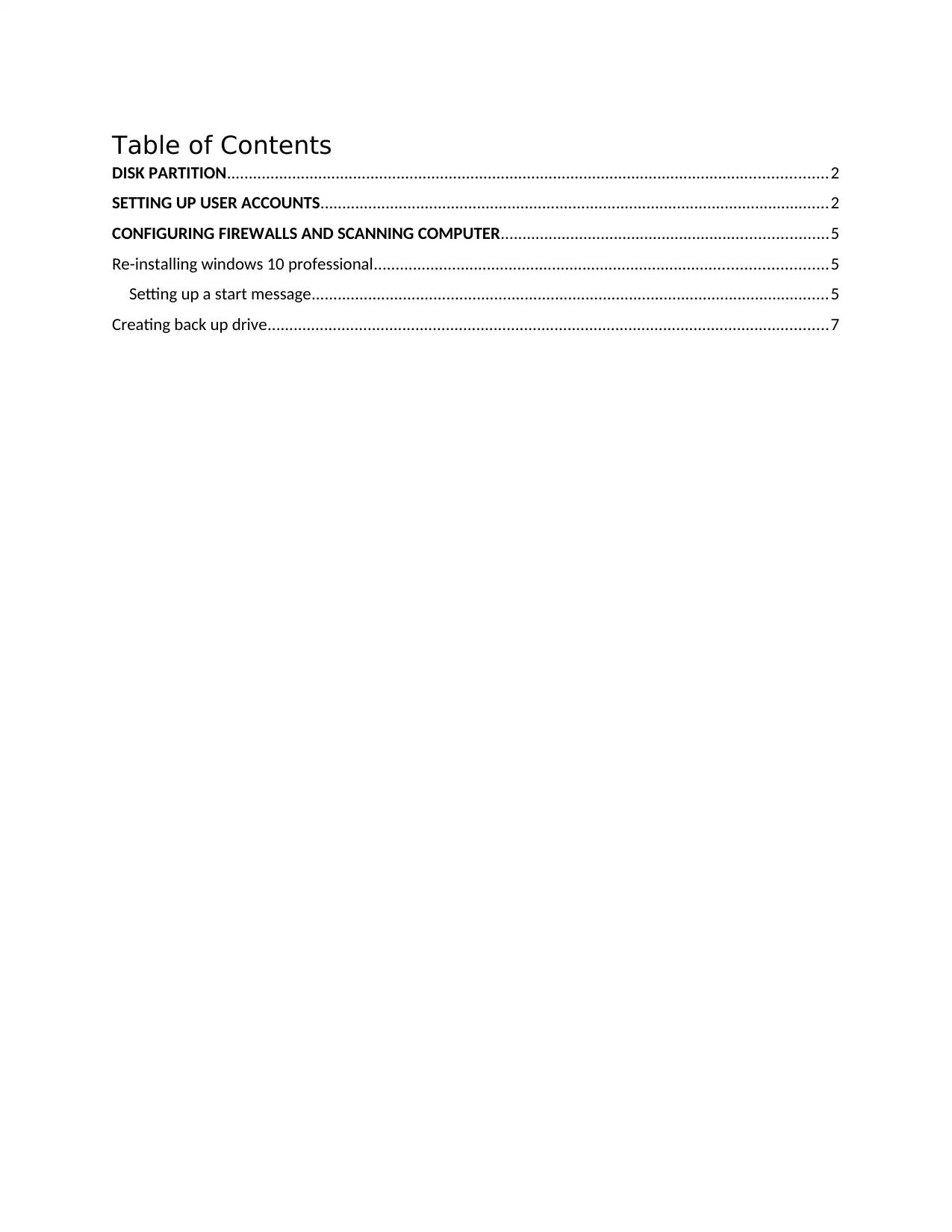
Table of Contents
DISK PARTITION..........................................................................................................................................2
SETTING UP USER ACCOUNTS.....................................................................................................................2
CONFIGURING FIREWALLS AND SCANNING COMPUTER...........................................................................5
Re-installing windows 10 professional........................................................................................................5
Setting up a start message.......................................................................................................................5
Creating back up drive.................................................................................................................................7
DISK PARTITION..........................................................................................................................................2
SETTING UP USER ACCOUNTS.....................................................................................................................2
CONFIGURING FIREWALLS AND SCANNING COMPUTER...........................................................................5
Re-installing windows 10 professional........................................................................................................5
Setting up a start message.......................................................................................................................5
Creating back up drive.................................................................................................................................7
Paraphrase This Document
Need a fresh take? Get an instant paraphrase of this document with our AI Paraphraser

DISK PARTITION
Partitioning is dividing hard disk into different logical disk. Partitioning is mainly done to create a space
where operating system will be installed and where user files can be stored. When creating partition
windows automatically create some other partitions used for file recovery.
How to create partitions
To create partitions, delete the disk space. Deleting the disk will remove all data and the letter assigned
to the disk. Click the disk to delete and click the delete button and confirm you want delete the disk. The
disk will be labelled as unallocated disk after deletion.
Click on the disk and click the new button on the bottom right. To choose the size of the disk enter disk
space using MB. Create a disk space greater than 50GB for the partition to hold the OS and other
programs. Chose file format of the partitions before finishing creating the partitions. Some formats are
available but it is advisable to use NTFS file system. Repeat the same process for the remaining
partitions. Use the remaining space to create the second partition.
Why choose NTFS
The format can support a maximum storage of 2TB. It is has security and recovery feature. The format
scheme allows for file encryption and file compression without using any software. It is built to operate
with operating system and file systems.
SETTING UP USER ACCOUNTS
When OS installation is complete a series of steps will followed to start the machine. One of the process
is to create user account. The user account created at the begin will have the administration rights.
Create the user as Kaalia Grava. Provide the user password and confirm the password. Choose and
answer the security question to complete setting up the account.
How to create standard user accounts
To create standard user accounts you have to navigate to users accounts.
Steps
1. Press on the windows button on your keyboard or click the user icon at the right bottom of your
screen.
2. Navigate to setting and click the setting icons.
3. Double click on the accounts
4. Select family and others people
5. Click add someone else on this pc button
6. Provide the username and the password confirm the password.
7. Answer the option question and create account.
Tap the windows icon followed by power icon on top click the user icon. You will find the new user
created. Chose the user to switch the accounts.
Partitioning is dividing hard disk into different logical disk. Partitioning is mainly done to create a space
where operating system will be installed and where user files can be stored. When creating partition
windows automatically create some other partitions used for file recovery.
How to create partitions
To create partitions, delete the disk space. Deleting the disk will remove all data and the letter assigned
to the disk. Click the disk to delete and click the delete button and confirm you want delete the disk. The
disk will be labelled as unallocated disk after deletion.
Click on the disk and click the new button on the bottom right. To choose the size of the disk enter disk
space using MB. Create a disk space greater than 50GB for the partition to hold the OS and other
programs. Chose file format of the partitions before finishing creating the partitions. Some formats are
available but it is advisable to use NTFS file system. Repeat the same process for the remaining
partitions. Use the remaining space to create the second partition.
Why choose NTFS
The format can support a maximum storage of 2TB. It is has security and recovery feature. The format
scheme allows for file encryption and file compression without using any software. It is built to operate
with operating system and file systems.
SETTING UP USER ACCOUNTS
When OS installation is complete a series of steps will followed to start the machine. One of the process
is to create user account. The user account created at the begin will have the administration rights.
Create the user as Kaalia Grava. Provide the user password and confirm the password. Choose and
answer the security question to complete setting up the account.
How to create standard user accounts
To create standard user accounts you have to navigate to users accounts.
Steps
1. Press on the windows button on your keyboard or click the user icon at the right bottom of your
screen.
2. Navigate to setting and click the setting icons.
3. Double click on the accounts
4. Select family and others people
5. Click add someone else on this pc button
6. Provide the username and the password confirm the password.
7. Answer the option question and create account.
Tap the windows icon followed by power icon on top click the user icon. You will find the new user
created. Chose the user to switch the accounts.
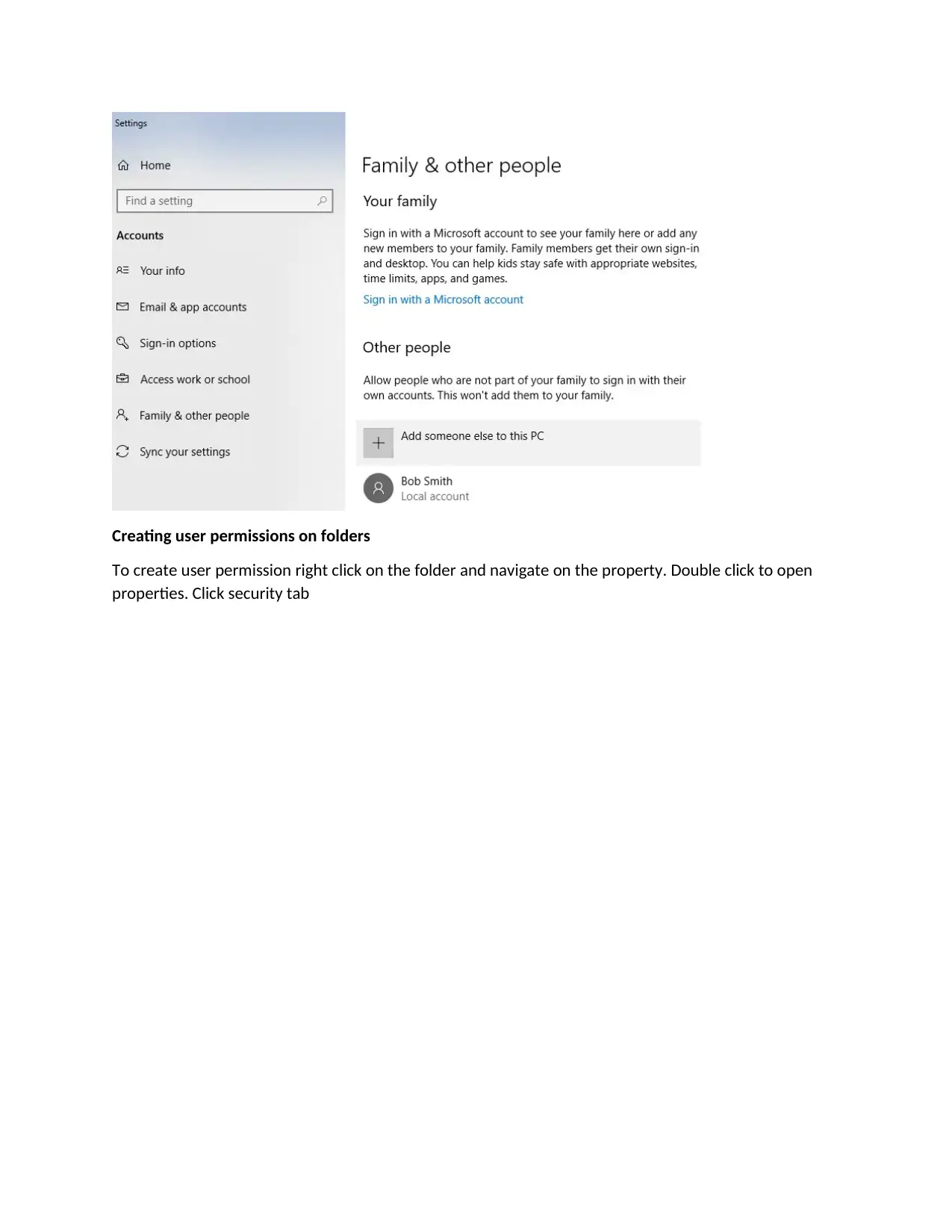
Creating user permissions on folders
To create user permission right click on the folder and navigate on the property. Double click to open
properties. Click security tab
To create user permission right click on the folder and navigate on the property. Double click to open
properties. Click security tab
⊘ This is a preview!⊘
Do you want full access?
Subscribe today to unlock all pages.

Trusted by 1+ million students worldwide
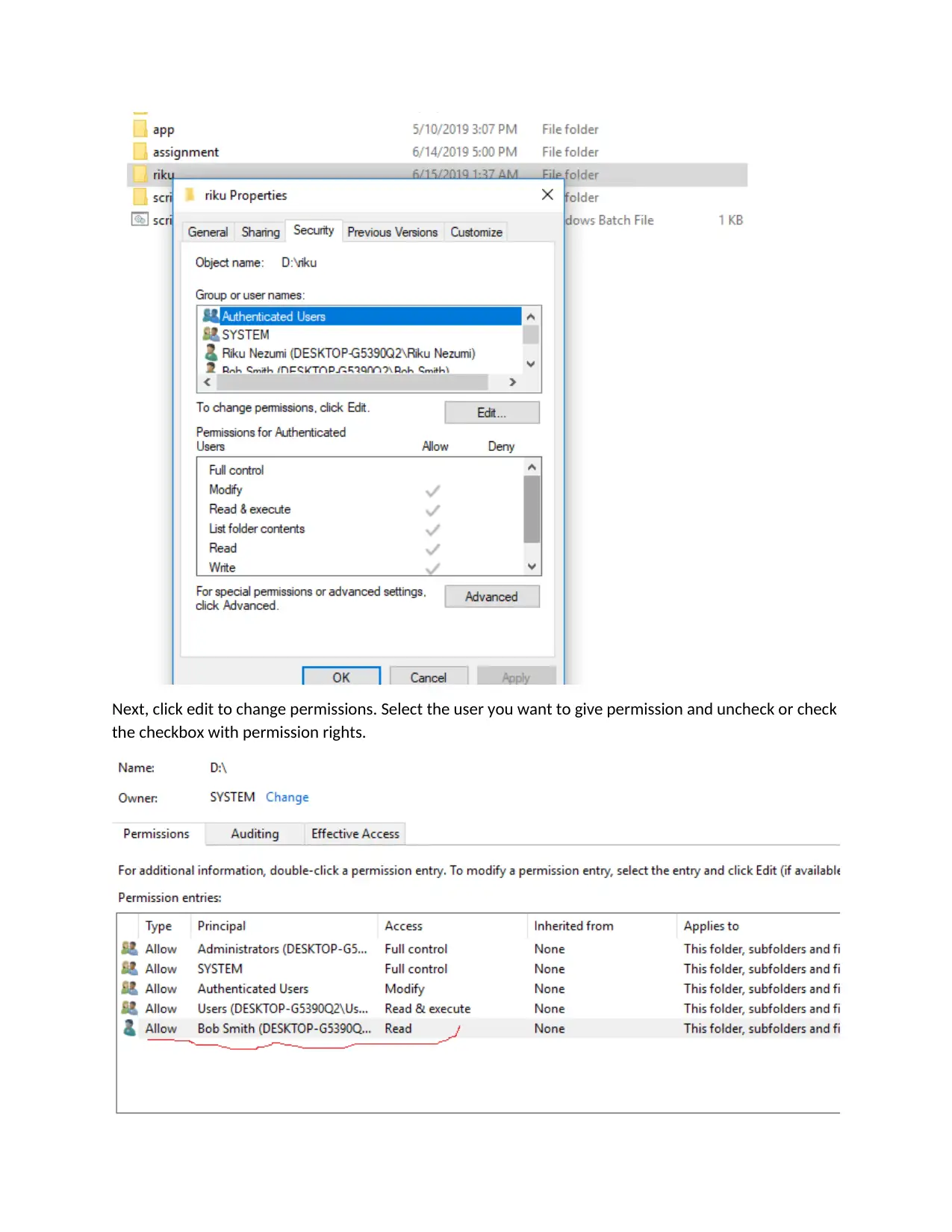
Next, click edit to change permissions. Select the user you want to give permission and uncheck or check
the checkbox with permission rights.
the checkbox with permission rights.
Paraphrase This Document
Need a fresh take? Get an instant paraphrase of this document with our AI Paraphraser
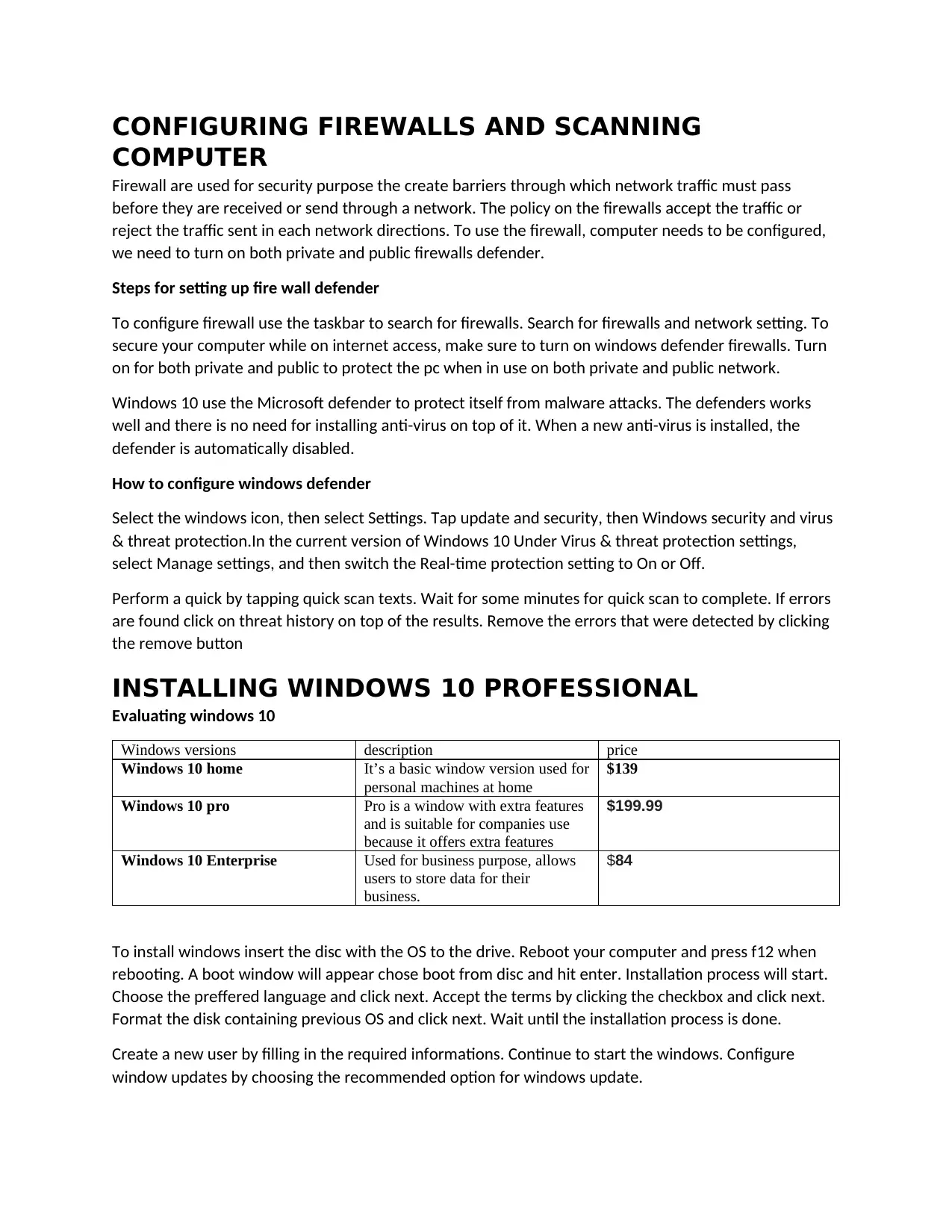
CONFIGURING FIREWALLS AND SCANNING
COMPUTER
Firewall are used for security purpose the create barriers through which network traffic must pass
before they are received or send through a network. The policy on the firewalls accept the traffic or
reject the traffic sent in each network directions. To use the firewall, computer needs to be configured,
we need to turn on both private and public firewalls defender.
Steps for setting up fire wall defender
To configure firewall use the taskbar to search for firewalls. Search for firewalls and network setting. To
secure your computer while on internet access, make sure to turn on windows defender firewalls. Turn
on for both private and public to protect the pc when in use on both private and public network.
Windows 10 use the Microsoft defender to protect itself from malware attacks. The defenders works
well and there is no need for installing anti-virus on top of it. When a new anti-virus is installed, the
defender is automatically disabled.
How to configure windows defender
Select the windows icon, then select Settings. Tap update and security, then Windows security and virus
& threat protection.In the current version of Windows 10 Under Virus & threat protection settings,
select Manage settings, and then switch the Real-time protection setting to On or Off.
Perform a quick by tapping quick scan texts. Wait for some minutes for quick scan to complete. If errors
are found click on threat history on top of the results. Remove the errors that were detected by clicking
the remove button
INSTALLING WINDOWS 10 PROFESSIONAL
Evaluating windows 10
Windows versions description price
Windows 10 home It’s a basic window version used for
personal machines at home
$139
Windows 10 pro Pro is a window with extra features
and is suitable for companies use
because it offers extra features
$199.99
Windows 10 Enterprise Used for business purpose, allows
users to store data for their
business.
$84
To install windows insert the disc with the OS to the drive. Reboot your computer and press f12 when
rebooting. A boot window will appear chose boot from disc and hit enter. Installation process will start.
Choose the preffered language and click next. Accept the terms by clicking the checkbox and click next.
Format the disk containing previous OS and click next. Wait until the installation process is done.
Create a new user by filling in the required informations. Continue to start the windows. Configure
window updates by choosing the recommended option for windows update.
COMPUTER
Firewall are used for security purpose the create barriers through which network traffic must pass
before they are received or send through a network. The policy on the firewalls accept the traffic or
reject the traffic sent in each network directions. To use the firewall, computer needs to be configured,
we need to turn on both private and public firewalls defender.
Steps for setting up fire wall defender
To configure firewall use the taskbar to search for firewalls. Search for firewalls and network setting. To
secure your computer while on internet access, make sure to turn on windows defender firewalls. Turn
on for both private and public to protect the pc when in use on both private and public network.
Windows 10 use the Microsoft defender to protect itself from malware attacks. The defenders works
well and there is no need for installing anti-virus on top of it. When a new anti-virus is installed, the
defender is automatically disabled.
How to configure windows defender
Select the windows icon, then select Settings. Tap update and security, then Windows security and virus
& threat protection.In the current version of Windows 10 Under Virus & threat protection settings,
select Manage settings, and then switch the Real-time protection setting to On or Off.
Perform a quick by tapping quick scan texts. Wait for some minutes for quick scan to complete. If errors
are found click on threat history on top of the results. Remove the errors that were detected by clicking
the remove button
INSTALLING WINDOWS 10 PROFESSIONAL
Evaluating windows 10
Windows versions description price
Windows 10 home It’s a basic window version used for
personal machines at home
$139
Windows 10 pro Pro is a window with extra features
and is suitable for companies use
because it offers extra features
$199.99
Windows 10 Enterprise Used for business purpose, allows
users to store data for their
business.
$84
To install windows insert the disc with the OS to the drive. Reboot your computer and press f12 when
rebooting. A boot window will appear chose boot from disc and hit enter. Installation process will start.
Choose the preffered language and click next. Accept the terms by clicking the checkbox and click next.
Format the disk containing previous OS and click next. Wait until the installation process is done.
Create a new user by filling in the required informations. Continue to start the windows. Configure
window updates by choosing the recommended option for windows update.
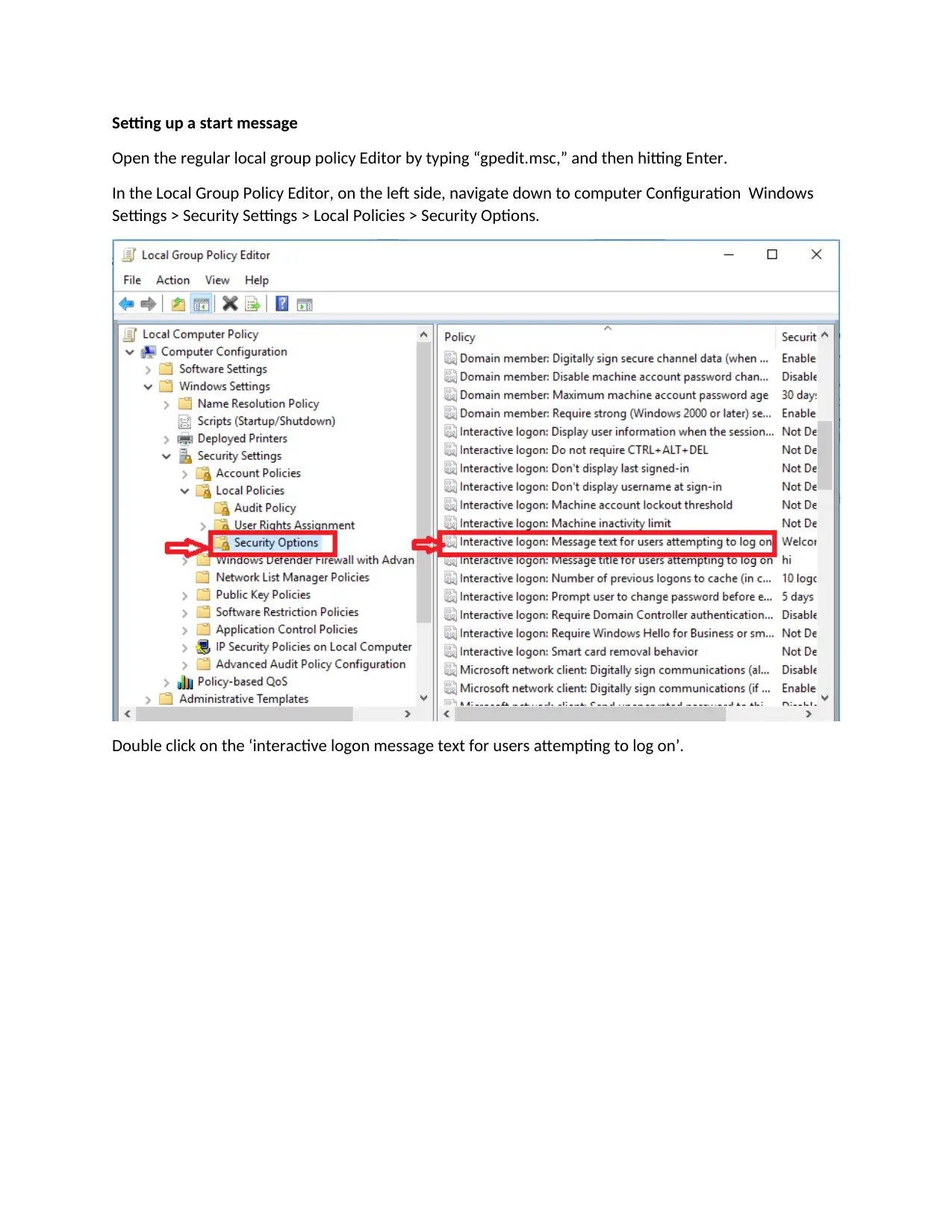
Setting up a start message
Open the regular local group policy Editor by typing “gpedit.msc,” and then hitting Enter.
In the Local Group Policy Editor, on the left side, navigate down to computer Configuration Windows
Settings > Security Settings > Local Policies > Security Options.
Double click on the ‘interactive logon message text for users attempting to log on’.
Open the regular local group policy Editor by typing “gpedit.msc,” and then hitting Enter.
In the Local Group Policy Editor, on the left side, navigate down to computer Configuration Windows
Settings > Security Settings > Local Policies > Security Options.
Double click on the ‘interactive logon message text for users attempting to log on’.
⊘ This is a preview!⊘
Do you want full access?
Subscribe today to unlock all pages.

Trusted by 1+ million students worldwide
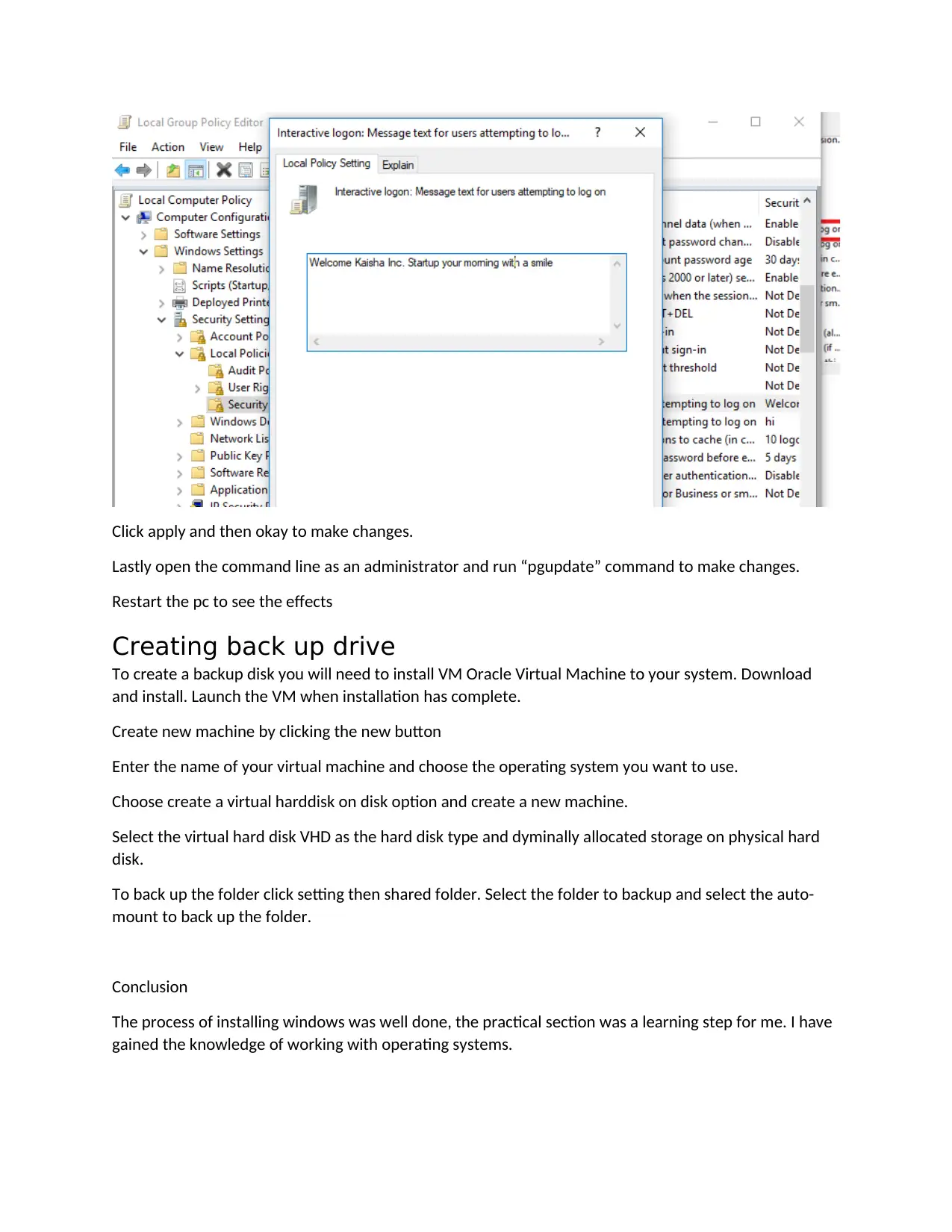
Click apply and then okay to make changes.
Lastly open the command line as an administrator and run “pgupdate” command to make changes.
Restart the pc to see the effects
Creating back up drive
To create a backup disk you will need to install VM Oracle Virtual Machine to your system. Download
and install. Launch the VM when installation has complete.
Create new machine by clicking the new button
Enter the name of your virtual machine and choose the operating system you want to use.
Choose create a virtual harddisk on disk option and create a new machine.
Select the virtual hard disk VHD as the hard disk type and dyminally allocated storage on physical hard
disk.
To back up the folder click setting then shared folder. Select the folder to backup and select the auto-
mount to back up the folder.
Conclusion
The process of installing windows was well done, the practical section was a learning step for me. I have
gained the knowledge of working with operating systems.
Lastly open the command line as an administrator and run “pgupdate” command to make changes.
Restart the pc to see the effects
Creating back up drive
To create a backup disk you will need to install VM Oracle Virtual Machine to your system. Download
and install. Launch the VM when installation has complete.
Create new machine by clicking the new button
Enter the name of your virtual machine and choose the operating system you want to use.
Choose create a virtual harddisk on disk option and create a new machine.
Select the virtual hard disk VHD as the hard disk type and dyminally allocated storage on physical hard
disk.
To back up the folder click setting then shared folder. Select the folder to backup and select the auto-
mount to back up the folder.
Conclusion
The process of installing windows was well done, the practical section was a learning step for me. I have
gained the knowledge of working with operating systems.
Paraphrase This Document
Need a fresh take? Get an instant paraphrase of this document with our AI Paraphraser

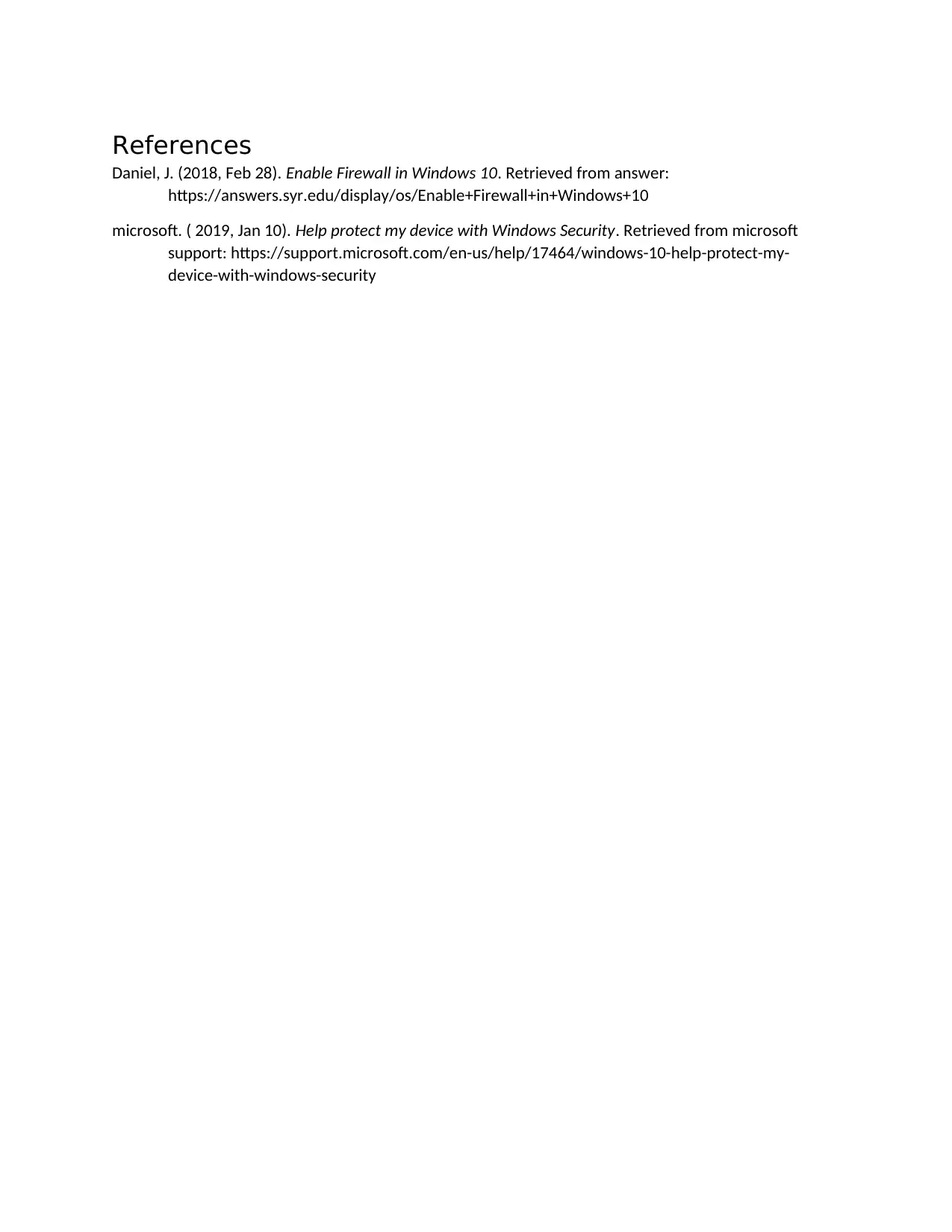
References
Daniel, J. (2018, Feb 28). Enable Firewall in Windows 10. Retrieved from answer:
https://answers.syr.edu/display/os/Enable+Firewall+in+Windows+10
microsoft. ( 2019, Jan 10). Help protect my device with Windows Security. Retrieved from microsoft
support: https://support.microsoft.com/en-us/help/17464/windows-10-help-protect-my-
device-with-windows-security
Daniel, J. (2018, Feb 28). Enable Firewall in Windows 10. Retrieved from answer:
https://answers.syr.edu/display/os/Enable+Firewall+in+Windows+10
microsoft. ( 2019, Jan 10). Help protect my device with Windows Security. Retrieved from microsoft
support: https://support.microsoft.com/en-us/help/17464/windows-10-help-protect-my-
device-with-windows-security
⊘ This is a preview!⊘
Do you want full access?
Subscribe today to unlock all pages.

Trusted by 1+ million students worldwide
1 out of 9
Related Documents
Your All-in-One AI-Powered Toolkit for Academic Success.
+13062052269
info@desklib.com
Available 24*7 on WhatsApp / Email
![[object Object]](/_next/static/media/star-bottom.7253800d.svg)
Unlock your academic potential
Copyright © 2020–2025 A2Z Services. All Rights Reserved. Developed and managed by ZUCOL.





